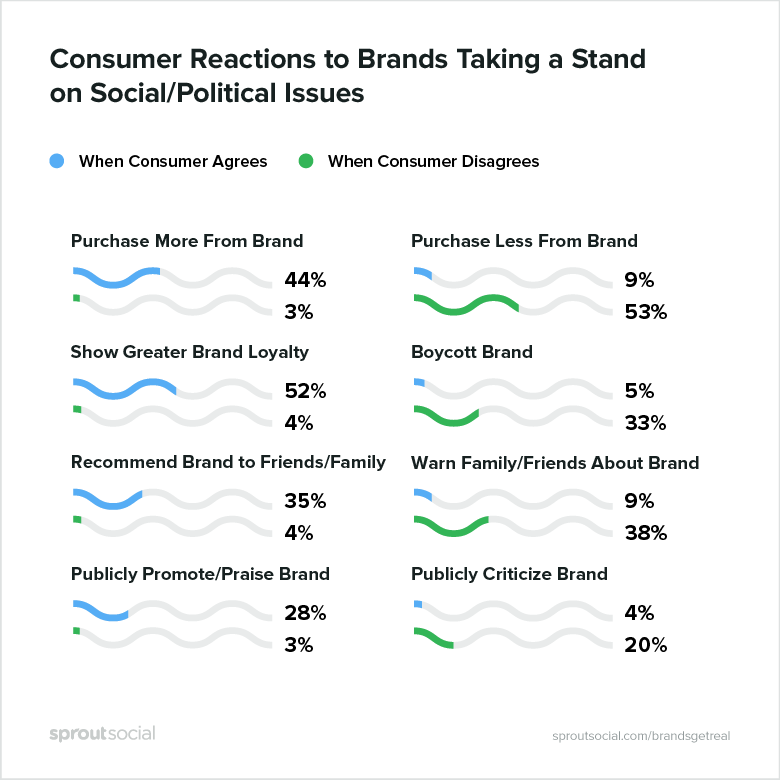In times of turmoil, we look for leaders. Strong voices, espousing strong values, promoting unity and positive change.
But what if that voice comes from a brand?
We’ve seen and heard it before – brand communicators stepping outside their expected lane to speak on social issues. Whether that’s Ben & Jerry’s calling for the dismantling of white supremacy, Nike making Colin Kaepernick the face of their campaign in 2018, or any of the numerous brands making statements and donations in the wake of George Floyd’s death, this approach to brand activism can be provocative, inspiring, or co-optive (depending on who you ask, how it was executed, and your level of cynicism).
Sometimes new leadership can push brands in new directions. Other times it comes from global events. But what are the risks of speaking up as a brand in the face of social progress? What is the cost of remaining silent? How do you know what to say and when?
Recent studies have found that consumer sentiment is often positive towards brand activism. In a 2018 survey by Sprout Social, 66% of consumers said it’s important for brands to take public stands on social and political issues.
In fact, when it comes to brand activism, positive feelings actually outweigh outrage. According to Sprout Social, when consumers agree with what a brand says, they’re more likely to praise the brand and report higher brand loyalty. The percentage of consumers who boycott a brand because they disagree with the brand’s position is notably lower.

Another 2018 survey by BRANDfog and McPherson Strategies found that 93% of consumers agreed that when they align with a statement from a CEO on key social issues, they’re more likely to make a purchase from that company.
With all that in mind, here are a few guidelines and positive examples to consider when it comes to brand activism:
Examine your internal culture
Look inward first. Are there any stumbling blocks in your own corporate practices that come between your brand and the social change you seek to promote? If you want to speak out on climate change, examine your own supply chain and carbon footprint. Is there anything to celebrate? Is there anything that can be improved? Be real, be honest, and develop an action plan. As part of their commitment to the #BlackLivesMatter movement, Pepsico made a commitment to increase their black manager population by 30%.
Support and amplify leaders
This is perhaps the most important step to avoid co-opting a movement. If you choose to take a stand with brand activism, recognize that your brand is not the hero here. A brand may not be the inspirational leader that a social movement needs, but it can provide a platform to amplify those leaders. That means shining the spotlight on nonprofits, artists, and activists who have been doing the hard work of promoting social change for years before this moment, and will continue to do so for years to come. If your brand has a wide reach on social media, consider “donating” your channel as a megaphone for nonprofits and leaders from marginalized communities.
Be brave, follow your values
Strong brand messaging is rooted in values. Knowing your brand values can guide how you craft your message. If you’re confident in your brand values, you’ll find confidence in your voice. Patagonia’s core values are directly reflected by their climate justice activism. In fact, the brand elevates and leads with their activism – making it 1 of 4 top line navigation buttons on their website.
Take meaningful action
Avoid empty virtue signaling by pairing your statements and slogans with meaningful and significant action. Make a sizable donation to a worthy nonprofit. Make a commitment to improving diverse representation in your CSuite. Whatever it is, do something of substance. In a move towards transparent accountability, Lush Cosmetics laid out their 90 day action plan in a public post to hold them accountable to permanent change towards fighting systemic racism.
True social change requires human effort, emotion, empathy, and action. There is a role for brands to play, and it must be done genuinely and from the inside out.
